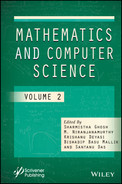15
Investigation of Viscoelastic Magnetohydrodynamics (MHD) Flow Over an Expanded Lamina Surrounded in a Permeable Media
Hiranmoy Mondal1⋆, Arindam Sarkar2 and Raj Nandkeolyar2
1Department of Applied Science, Maulana Abul Kalam Azad University of Technology, West Bengal, Kolkata, India
2Department of Mathematics, National Institute of Technology Jamshedpur, Jamshedpur, India
Abstract
The results of the boundary value problem of MHD nanofluid micropolar fluid flow have been carried out throughout this study. Using the spectral quasi-linearization method (SQLM), the mass as well as heat transfer effects of fluid have been investigated. A stream consists of viscous dissipation, bouncy force, thermal radiation, and Joule heating. It has been scrutinized that the existence of magnetic parameter Mn enhances concentration and temperature gradient, whereas the appearance of permeable media turns down the velocity profile.
Keywords: Stretching surface, MHD flow, darcy dissipation, viscoelastic liquid, nanofluids, chemical reaction, spectral quasi linearization method
15.1 Introduction
15.1.1 Literature Review
Viscoelastic Magneto-hydrodynamic nanofluids through a stretching sheet have a broad range of practical applications in industries such as paper production, metal spinning, relegation of plastic lamina, continuous welding of metals, production of synthetic sheets, removal of heat from metallic sheets, etc.
The study of magnetohydrodynamics (MHD) takes place as an essential part in thermodynamics, especially during the determination of boundary layer flow for cooling of nuclear reactors, high-temperature plasmas, etc. [1]. Pal and Mondal [2] reported that the stretching parameter and velocity profile are inversely related. Baag et al. [3] investigated the entropy generation through an electrically-conducting viscoelastic MHD fluid stream upon an exponentially expanded porous lamina. The boundary layer equations have been solved via Kummer’s function. The viscoelastic and magnetic parameters were shown to be inversely related to velocity, whereas the elastic parameter was linearly proportional to velocity. Furthermore, porous matrix and the inverse of the Prandtl number were found to be directly proportional to temperature [3]. Also, Pal and Mondal [4] studied laminar, unwavering, and convective boundary layer Newtonian fluid streams. They examined the heat absorbing/producing effect of the fluid which is passing through a non-isothermal along with the thermal radiation immersed in a permeable surface.
15.1.2 Nomenclature
| B0 | Strength of uniform magnetic field |
| Cp | Specific heat of the fluid |
| f | Stream function |
| K | Thermal conductivity of the fluid |
| Mn | Magnetic parameter |
| R | Radiation parameter |
| T | Non-dimensional temperature |
| T∞ | Ambient temperature/temperature far from sheet |
| ρ | Density of the fluid |
| Kp | Porosity parameter |
| k0 | Dimensionless elastic parameter |
| Porosity parameter | |
| s | Plate concentration parameter |
| r | Plate temperature parameter |
| D | Molecular diffusivity |
| DB | Brownian motion coefficient |
| DT | Thermophoretic diffusion coefficient |
| μ | Dynamic viscosity |
| ν | Kinematic coefficient of viscosity |
| σ | Electrical conductivity |
| Rc | Elastic parameter |
| Pr | Prandtl number |
| Nt | Thermophoresis parameter |
| Nb | Brownian motion parameter |
| Le | Lewis number |
At present, nanofluids are very significant in engineering applications as well as biomedical science, as it increases heat transfer and energy efficiency in various kinds of thermal systems. Nanofluid is a special kind of heat transfer medium containing oxides or metals, e.g., zinc oxide, copper oxide, alumina or iron oxide having a radius less than 100 nm, which are equally and stably spread out in a base fluid like water, oil, acetone, etc. Over the last few years, nanofluids have drawn a substantial amount of attention for their unique properties which are very beneficial in the chemical and metallurgical area, cooling, ventilation, thermal therapy for cancer treatment, power generation, micro-manufacturing, and air conditioning. The literature survey shows that during the past few decades, curiosity around fluid flowing through a stretching surface has grown. Crane [5] investigated constant stretching surface temperature problems. Later on, a small number of researchers investigated the outcomes of chemical repercussions, heat and mass alternation, thermal slip conditions of various non-Newtonian fluids, or probable combined effects of the above [6–11].
Due to countless industrial applications like power generation system and modern metallurgical processes, many researches have been attracted to the MHD electrically conducting fluid flow. Hayat et al. [12] considered an unperturbed incompressible MHD Walter-B nanofluid flow that is passing through a nonlinear stretching surface. Using homotopy analysis they deciphered their mathematical model, whereas Daniel et al. [13] did his research in the heat alternation effect of MHD nanofluid stream take across a porous stretching surface. Hayat et al. [14] studied the heat transmission of a nanofluid stream with various dissipation and Joule heating along a permeable stretched cylinder and the stream was subjected to nonlinear thermal diffusion with homogeneous-heterogeneous reactions. They used an Explicit Euler formula to resolve their fluid model. Hayat et al. [15] calculated the effect of melting heat distribution of a MHD nanofluid genre with nonlinear thermal diffusion in regards to the stagnation point along an expanded lamina. Using homotopy analysis they deciphered their flow equations. Kishan and Maripala [16] presented a mathematical model of the Darcy Forchheimer MHD boundary layer stream by a permeable expanded lamina. They also calculated the thermophoresis and viscous dissipation. The perusal of a hydromagnetic stream of an electrically conducting fluid has drawn a significant observation due to its applications in recent metallurgical and metal-working processes. The effect of a magnetic field is an important part to manage the momentum as well as heat conduction in the boundary layer stream of various kind of fluids. Several researchers (Ibrahim et al. [17], Turkyilmazoglu [18], Farooq et al. [19], Sheikholeslami et al. [20], Baag et al. [21], Sheikholeslami et al. [22], Abdul Hakeem et al. [23]) studied about the impact of magnetic field on MHD fluid.
It is immensely important to scrutinize the behavior of heat absorption/production on account of several kinds of physical models in modern days. Eldahab and Aziz [24] have investigated the results of uneven heat exploitation/whiff effect of viscous fluid with thermal radiation. Abel et al. [25] examined the non-Newtonian MHD viscoelastic fluid upon a flat lamina. Ganga et al. [26] investigated the entropy generation on nanofluid flow through an expanded lamina by considering velocity slip condition and nonlinear thermal radiation. The study of heat distribution analysis for multiphase magnetic fluid passing through a flat lamina with heat exploitation/production and thermal diffusion was scrutinized by Zeeshan et al. [27]. The spectral quasi-linearization method (SQLM) is an important numerical method to solve highly nonlinear differential equation in fluid dynamics. Mondal et al. [28] and Motsa [29] used this method to solved the mathematical problem of the fluid flow.
The originality of the recent perusal is to consider the chemical reaction and thermophoresis effect on the viscoelastic MHD nanofluid flow. The values of (Cf), (Nu), and (Sh) for different parameters has been discussed numerically. The outcome of this study will provide useful information for applications in several engineering processes along with a complement to the prior perusal.
15.2 Formulation of the Problem
Along the way of the main stream of the lamina, the x − axis has been considered and the direction of the y – axis is perpendicular to the lamina with velocity components u, v along the x – axis and y – axis, respectively as demonstrated in Figure 15.1.
The ruling equations of two-dimensional stream considering the boundary layer approximation are presented in this fashion:

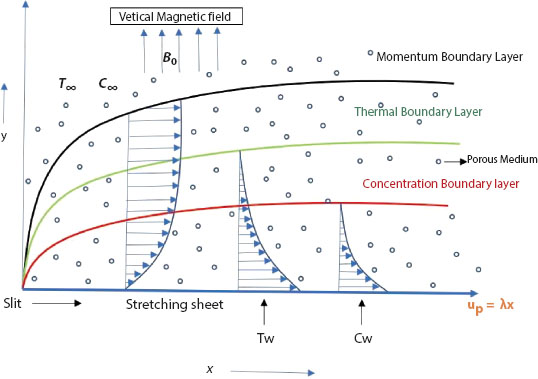
Figure 15.1 Schematic diagram.
The relevant boundary conditions are
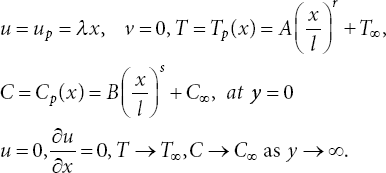
15.2.1 Analytical Solution
The stream function Ψ(x, y) is worthwhile for the continuity equation

Considering the similarity conversion

Substituting all the above values, Equations (15.2), (15.3), and (15.4) are transformed as follows:
Wherein f′(η) stand for the differentiation of f with respect to η, ![]() represents Brownian motion parameter,
represents Brownian motion parameter, ![]() represents the thermophoresis parameter,
represents the thermophoresis parameter, ![]() is the Prandtl number,
is the Prandtl number, ![]() is the Lewis number, and
is the Lewis number, and ![]() .
.
15.2.2 Numerical Methods (Spectral Quasi-Linearization Methods)
Amalgamated with boundary condition (15.10), the nonlinear-coupled ordinary differential Equations (15.7), (15.8), and (15.9) are solved numerically, applying the spectral quasi-linearization method (SQLM).
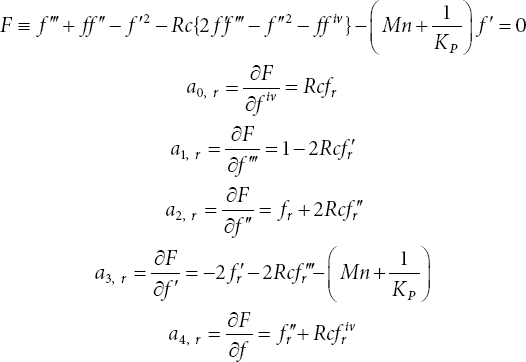
The linear term is as follows:
The nonlinear term of the energy equation is:

The converted linear term is as follows:
The nonlinear term of the concentration equation is:

The converted linear term is as follows:
15.3 Result and Argument
The effect of ruling parameters on the skin-friction coefficient, Nusselt number, and Sherwood number has been presented in the following, Table 15.1 from tabular data we observe that (Cf) enhances with a rise in both magnetic parameter and thermophoresis parameter, whereas (Cf) reduces with enhancement in Soret number, chemical repercussion, and Brownian motion parameter. Nu reduces monotonically with enhancement in Soret number and rises with enhancement in magnetic, Brownian, and thermophoresis parameters and chemical reaction. Further, it has been audited that the sequel of magnetic parameter, thermophoresis parameter, and Soret number is to enhance the Sherwood number and reverse the effects of chemical reactions. The Brownian motion parameter has been observed on the Sherwood number.
Table 15.1 Values (Cf), (Nu), and (Sh) for different parameters.
| Mn | Sr | R1 | Nb | Nt | −f″(0) | −θ′(0) | −Ø′(0) |
|---|---|---|---|---|---|---|---|
| 0.0 | 0.7 | 0.2 | 0.5 | 0.2 | 6.47747836 | -1.24792674 | -0.16130247 |
| 0.2 | 6.68965205 | -1.23881769 | -0.15872752 | ||||
| 0.6 | 7.09600494 | -1.22067600 | -0.15482334 | ||||
| 0.2 | 0.7 | 0.2 | 0.5 | 0.2 | 6.68965205 | -1.23881769 | -0.15872752 |
| 1.6 | 6.68959350 | -2.06833985 | 0.15987681 | ||||
| 5.0 | 6.69009405 | -4.33945643 | 1.04495979 | ||||
| 0.2 | 0.7 | 0.0 | 0.5 | 0.2 | 6.68959327 | -1.57062405 | 0.21775166 |
| 0.4 | 6.69037312 | -1.09209497 | -0.36582335 | ||||
| 0.6 | 6.69002619 | -1.00077201 | -0.51685468 | ||||
| 0.2 | 0.7 | 0.2 | 0.2 | 0.2 | 6.68988106 | -1.67046286 | 0.80664545 |
| 0.6 | 6.68993581 | -1.12522670 | -0.25586930 | ||||
| 0.8 | 6.69012545 | -0.93800745 | -0.36733042 | ||||
| 0.2 | 0.7 | 0.2 | 0.5 | 0.1 | 6.68959286 | -1.32703668 | -0.32973517 |
| 0.4 | 6.68990575 | -1.09355804 | 0.11126215 | ||||
| 0.7 | 6.69039059 | -0.93732032 | 0.40484395 |
Figures 15.2 and 15.3 show a graph of Mn on f′(η) and f(η), respectively. Through Figure 15.4 it can be audited that the result of Mn enhances the concentration at all points.
Figures 15.5 and 15.6 portray the temperature gradient θ(η) for several values of the magnetic parameter Mn and Prandtl number Pr. It has been audited that in Figure 15.5, θ(η) increases with η and it does not depend on the value of the Prandtl number, thermophoresis parameter, Lewis parameter, etc., whereas Figure 15.7 portrays an enhancement in the elastic parameter Rc, which decreases the transverse velocity f(η) for Mn = 2.

Figure 15.2 Result of Mn on f′(η) for Rc = 0.1, Pr = 8.
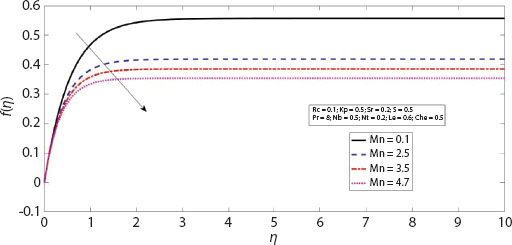
Figure 15.3 Results of Mn on f(η) for Rc = 0.1, Pr = 8.

Figure 15.4 Results of Mn on Ø(η) for Rc = 0.1, Pr = 8.

Figure 15.5 Results of Mn on θ(η) for Rc = 0.1, Pr = 8.
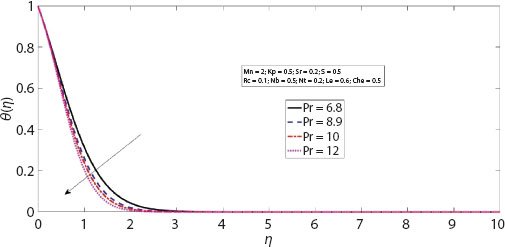
Figure 15.6 Results of Pr on θ(η) for Mn = 2.

Figure 15.7 Results of Rc on f(η) for Mn = 2.
The concentration profiles Ø(η) for various values of chemical repercussion parameter Che are portrayed in Figure 15.8. The temperature and chemical reaction parameters are inversely related.
The influence of the plate concentration parameter S, Lewis parameter Le, and Porosity parameter Kp on the concentration profile is shown in Figure 15.9, 15.10, and 15.11. From Figures 15.8 and 15.9, it is audited that concentration gradient parameter Ø(η) diminishes with η for Mn keeping constant, Mn = 2, i.e., the plate concentration parameter and Lewis parameter are inversely proportional with concentration gradient. It is also audited that with the enhancement on η, after a certain time there will be no effect of plate concentration parameters on concentration gradient. Figure 15.11 illustrates the result of porosity parameter on velocity gradient and it is seen that appearance of porous matrix increases the velocity at each point and after a certain time, transverse velocity becomes parallel to the axis of η.

Figure 15.8 Results of chemical reaction on Ø(η) for Mn = 2, Rc = 0.1, S = 0.5, Pr = 8.

Figure 15.9 Results of plate concentration on Ø(η) for Mn = 2, Rc = 0.1, Che = 0.5.
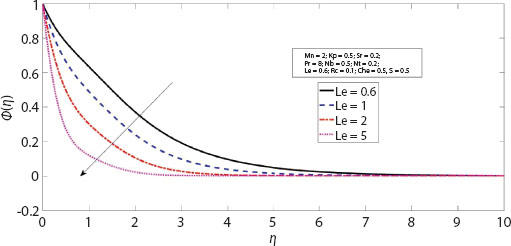
Figure 15.10 Results of Lewis parameter Le on Ø(η) for Mn = 2, Rc = 0.1, Che = 0.5.

Figure 15.11 Results of Kp on f(η) for Mn = 2, Rc = 0.1, Che = 0.5.
15.4 Conclusion
The solutions for a steady boundary layer stream and heat distribution for a nanofluid throughout an exponentially expanded lamina in the presence of a chemical reaction is analysed. Results of the magnetic parameter and the viscoelastic parameter on various velocities are discussed. The impression of the magnetic parameter, Prandtl number, and the heat sink/source parameter on the temperature profiles are presented. The main findings of this research may be shortened as follows:
- Concentration and temperature are directly proportional to the magnetic parameter
- Elastic parameter decreases the temperature at every point
- Plate concentration parameter and Lewis parameter are inversely proportional with concentration profile
- Presence of magnetic parameter and porous matrix decreases the velocity at all points
References
- 1. D. Pal and H. Mondal, Influence of thermophoresis and Soret-Dufour on magnetohydrodynamic heat and mass transfer over a non-isothermal wedge with thermal radiation and Ohmic dissipation, J. Magn. Magn. Mater., 331, 250–255, 2013.
- 2. D. Pal and H. Mondal, Influence of Soret and Dufour on MHD buoyancy-driven heat and mass transfer over a stretching sheet in porous media with temperature-dependent viscosity, Nucl. Eng. Des., 256, 350–357, 1970.
- 3. S. Baag, S. R. Mishra, G. C. Dash, and M. R. Acharya, Entropy generation analysis for viscoelastic MHD flow over a stretching sheet embedded in a porous medium, Ain Shams Eng. J., 8, no. 4, 623–632, 2017.
- 4. D. Pal and H. Mondal, Influence of temperature-dependent viscosity and thermal radiation on MHD forced convection over a non-isothermal wedge, Appl. Math. Comput., 212, no. 1, 194–208, 2009.
- 5. Crane LJ. Flow past a stretching plane. Jape Math Phys (ZAMP), 21, 645–7, 1970.
- 6. Ishak A, Nazar R, Pop I. Heat transfer over a stretching surface with variable heat flux in micropolar fluids. Phys Lett A, 372, 559–61, 2008.
- 7. Ishak A, Nazar R, Arifin NM, Pop I. Mixed convection of the stagnation point flow towards a stretching vertical permeable sheet. Malaysian J Math Sci 2, 217–226, 2007.
- 8. Ishak A, Nazar R, Pop I. Mixed convection boundary layers in the stagnation point flow towards a stretching vertical permeable sheet. Mechanica 41, 509–518, 2006.
- 9. Yao S, Fang T, Zhong Y. Heat transfer of a generalized stretching/shrinking wall problem with convection boundary conditions. Commun Nonlinear Sci Numer Simul 16, 752–760, 2011.
- 10. Quasim M, Hayat T, Obaidat S. Radiation effect on the mixed convection flow of a viscoelastic fluid along an inclined stretching sheet. Z Naturforsch 67, 195–202, 2012.
- 11. Hayat T, Quasim M, Mesloub S. MHD flow and heat transfer over a stretching sheet with Newtonian heating with slip condition. Int J Numer Methods Fluid 66, 963–975, 2011.
- 12. Hayat, T., Qayyum, S., Alsaedi, A. and Ahmad, B., Magnetohydrodynamic (MHD) nonlinear convective flow of Walters-B nanofluid over a nonlinear stretching sheet with variable thickness, International Journal of Heat and Mass Transfer, 110, 506-514, 2017.
- 13. Daniel, Y.S., Aziz, Z.A., Ismail, Z. and Salah, F., Double stratification effects on unsteady electrical MHD mixed convection flow of nanofluid with viscous dissipation and Joule heating, Journal of Applied Research and Technology, 15(5), 464-476, 2017.
- 14. Hayat, T., Qayyum, S., Khan, M.I. and Alsaedi, A., Entropy generation in magnetohydrodynamic radiative flow due to rotating disk in presence of viscous dissipation and Joule heating, Physics of Fluids, 30(1), 017101, 2018.
- 15. Hayat, T., Qayyum, S., Alsaedi, A. and Shafiq, A., Inclined magnetic field and heat source/sink aspects in flow of nanofluid with nonlinear thermal radiation, International Journal of Heat and Mass Transfer, 103, 99-107, 2016.
- 16. Kishan, N. and Maripala, S., Thermophoresis and viscous dissipation effects on Darcy-Forchheimer MHD mixed convection in a fluid saturated porous media, Advances in Applied Science Research, 3(1), 60-74, 2012.
- 17. Ibrahim, W., Shankar, B. and Nandeppanavar, M.M., MHD stagnation point flow and heat transfer due to nanofluid towards a stretching sheet, Int. J. Heat Mass Transfer., 56, 1-9, 2013.
- 18. Turkyilmazoglu, M., Exact analytical solutions for heat and mass transfer of MHD slip flow in nanofluids, Chem. Eng. Sci., 84, 182-187, 2012.
- 19. Farooq, M., Ijaz Khan, M., Waqas, M., Hayat, T., Alsaedi, A. and Imran Khan, M., MHD stagnation point flow of viscoelastic nanofluid with non-linear radiation effects, Journal of Molecular Liquids., 221, 1097-1103, 2016.
- 20. Sheikholeslami, M., Hari Kataria, R. and Akhil Mittal, S., Effect of thermal diffusion and heat-generation on MHD nanofluid flow past an oscillating vertical plate through porous medium, Journal of Molecular Liquids, 257, 12-25, 2018.
- 21. Baag, S., Mishra, S. R., Dash, G. C. and Acharya, M. R., Entropy generation analysis for viscoelastic MHD flow over a stretching sheet embedded in a porous medium, Ain Shams Engineering Journal, 8(4), 623-632, 2017.
- 22. Sheikholeslami, M. and Rokni, H. B., Influence of melting surface on MHD nanofluid flow by means of two-phase model, Chinese J. Physics, 55(4), 1352-1360, 2017.
- 23. Abdul Hakeem, A.K., Govindaraju, M. and Ganga, B., Influence of inclined Lorentz forces on entropy generation analysis for viscoelastic fluid over a stretching sheet with nonlinear thermal radiation and heat source/sink, J. Heat Mass Transfer Research., 6(1), 1-10, 2019.
- 24. Emad M. Abo-Eladahab, Mohamed A. El Aziz, Blowing/suction effect on hydromagnetic heat transfer by mixed convection from an inclined continuously stretching surface with internal heat generation/absorption, Int. J. Therm. Sci., 43, 709-719, 2004.
- 25. Subhas Abel, M. and Mahesha, N., Heat transfer in MHD viscoelastic fluid flow over a stretching sheet with variable thermal conductivity, non-uniform heat source and radiation, Appl. Math. Model., 32, 1965-1983, 2008.
- 26. Ganga, B., Govindaraju, M. and Abdul Hakeem, A.K., Effects of inclined magnetic field on entropy generation in nanofluid over a stretching sheet with partial slip and nonlinear thermal radiation, Iranian Journal of Science and Technology: Transactions of Mechanical Engineering, 1139, 2018.
- 27. Zeeshan A, Majeed A. Effect of magnetic dipole on radiative non-Darcian mixed convective flow over a stretching sheet in porous medium. J Nanofluids 4, 617–626, 2016.
- 28. H Mondal, S Ghosh, PK Roy, S Chatterjee, Effects of Ion-Slip and Hall Currents on Magnetohydrodynamic Nanofluid Flow with Thermal Diffusion Using Spectral Quasi-Linearization Method, Journal of Nanofluids 10 (4), 608-615.
- 29. S. S. Motsa. A new spectral local linearization method for nonlinear boundary layer flow problems. Journal of Applied Mathematics, 2013.
Note
- ⋆ Corresponding author: [email protected]
